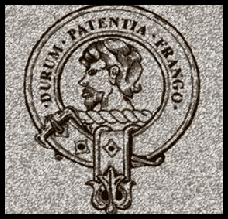the john muir exhibit - tartan - muir clan
John Muir's Scottish Ancestry:
Muir Clan or Gordon Clan?
by Harold Wood

Muir Clan Motto: Durum patientia frango (Latin: By patience I break what is hard)
The name "Muir" means 'living by a moor or heath'.
John Muir, born in Dunbar, Scotland in 1838, was undeniably a Scotsman, and it appears most of his ancestors on both sides were Scottish, although his grandmother on his father's side was English. But was he of the Clan Muir?
According to James Pringle Weavers, "Clan links should not be assumed without genealogical or geographical evidence, nor should Scottish ancestry be claimed on basis of name alone."
This advice seems to have been followed by Muir's biographers. In Linnie Marsh Wolfe's Pulitzer-Prize winning 1945 biography of John
Muir, John Muir: Son of the Wilderness , she asserts, without any explanatory footnote: "Mists veil the origin of the Muir family. We do know, however, that they belonged
to the Gordon Clan..." Other biographers appear to have accepted this assessment without question (e.g. Thurman Wilkins, John Muir, p. 5). Since John's father Daniel was orphaned as a baby, and had been raised by relatives, it is most difficult to accurately determine John Muir's actual clan affiliation.
In 1945 it might have been truthfully said that Muir's father Daniel was of the "Gordon Clan" - and indeed it might even have been so in 1838 when young John was born. But the fact is, there once was - and is again - a "Muir clan" of its own right. The Muir clan came into being in the 13th century, with a series of spellings. There are references to the name David E. More in the reign of King Alexander II (1214-1249), and the name spread widely in the 15th , 16th, and 17th centuries.
Scots of the Muir Clan can tell of the battles fought, the knighted Muirs, the brave deeds made during the turbulant years of Scottish history.
But in the year 1700, the Muir Clan came to an end. The last acknowledged Laird of the Clan died 1700, without having a male heir, leaving the Clan without a leader. Leaderless and
smaller clans frequently aligned themselves with larger clans for protection, such happened with Clan Muir during this period.
According to the contemporary Clan Muir Society:
"A line of Muir bearing a common descent from c. 1770 is linked to Clan Grant, while
others have links with Clan Leslie through a chief's marriage to a Muir
heiress in the 13th century, when a considerable part of her lands in Fife
passed to the Leslies. The clan was also absorbed as a sept by the
Gordons, the Campbells, the Donalds, and through Elizabeth Muir, the
Stewarts."
It appears that some of the contemporary clans, are gracefully letting Clan Muir resurrect itself, while others still claim Muir as a sept.
Today, the Clan Muir Society stated in the early 2000's: "While these clans recognize Muir as a sept, it is the stance of the Head of the Muir that Muir is not a sept of any clan, but a Clan unto itself." And they back up that claim by membership in the Council Of Scottish Clans & Associations, and in the year 2000 petitioned to have a chief, an honour that was bestowed on Andrew Moore, who goes by the title, "Head of the House of Muir."
However, as of August, 2019, the Society's website states: "Clan Muir is an Armigerous Clan which is to say we currently do not have a Chief. There is a movement in the Clan to begin the long process of having one appointed."
It thus appears that Clan Muir may be properly treated as an independent clan. In fact, the Clan Muir Society explicitly claims John Muir as one of their own, where they refer to two John Muir's on their website: "Sir John Muir was a military commander who fought against Napoleon and fell at the Battle of Corunna in Spain in 1809. Another John Muir, born at Dunbar in 1838, emigrated to America in 1849. He was a naturalist and first advocate of forest conservation in the United States, being responsible for the establishment of the internationally renowned Yosemite National Park."
In accord, the California State Tartan, intended to celebrate Scottish culture and heritage in California, was expressly modeled after the Muir clan tartan.
For more on the history of Clan Muir see:
http://www.clanmuir.org/
Home
| Alphabetical Index
| What's New & About this Site